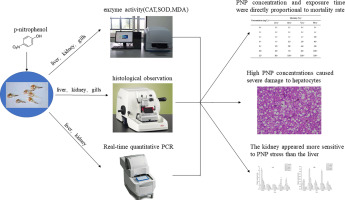当前位置:
X-MOL 学术
›
Comp. Biochem. Physiol. C Toxicol. Pharmacol.
›
论文详情
Our official English website, www.x-mol.net, welcomes your
feedback! (Note: you will need to create a separate account there.)
Effects of p-nitrophenol on enzyme activity, histology, and gene expression in Larimichthys crocea.
Comparative Biochemistry and Physiology C: Toxicology & Pharmacology ( IF 3.9 ) Pub Date : 2019-10-23 , DOI: 10.1016/j.cbpc.2019.108638 Siwen Kuang 1 , Qijun Le 2 , Jiabao Hu 1 , Yajun Wang 1 , Na Yu 1 , Xiaohuan Cao 1 , Man Zhang 1 , Yibo Sun 1 , Weiwei Gu 1 , Yang Yang 1 , Youyi Zhang 1 , Yaya Li 1 , Hanwei Liu 3 , Xiaojun Yan 1
Comparative Biochemistry and Physiology C: Toxicology & Pharmacology ( IF 3.9 ) Pub Date : 2019-10-23 , DOI: 10.1016/j.cbpc.2019.108638 Siwen Kuang 1 , Qijun Le 2 , Jiabao Hu 1 , Yajun Wang 1 , Na Yu 1 , Xiaohuan Cao 1 , Man Zhang 1 , Yibo Sun 1 , Weiwei Gu 1 , Yang Yang 1 , Youyi Zhang 1 , Yaya Li 1 , Hanwei Liu 3 , Xiaojun Yan 1
Affiliation

|
p-Nitrophenol (PNP) is one type of environmental pollutant, which is difficult to degrade and soluble in water. To investigate the effects of PNP on economically important marine fish species, we subjected Larimichthys crocea juvenile to five different concentrations of PNP for 96 h, and the semi-lethal concentration (LC50) was 6.218 mg/L. Then we collected the liver, kidney, and gill tissues to determine enzyme activity and gene expression levels, and analyzed histological changes. In histological analysis, the gills showed curling of lamella, epithelial lifting and hyperplasia; the parenchymal structure of hepatocytes was significantly damaged, with severe vacuolation and loss of original structure. The renal cells were damaged too, with congestion and renal tubular necrosis. Catalase and superoxide dismutase both showed an up- and down-tendency with the rise of concentration in the three tissues, and GSH-px had similar trend in the kidney, which decreased at 8 mg/L in the liver but showed no significant differences in the gills. Malondialdehyde of three tissues was increased with an increase in PNP concentration. The expression of four detoxification (cyp450, gst, gpx, hsp70) and one immune-related (mhc II) genes was induced at low PNP concentrations but inhibited at high PNP concentrations in the kidney. In liver, cyp450, hsp70 and mhc II showed similar trend but gst and gpx didn't increase at low PNP concentrations. Our results indicate that the fish possesses the ability to detoxify PNP; however, at high concentrations, PNP still causes serious damage to them. Our data not only help in understanding the ability of L. crocea to detoxify PNP but also should serve as a basis for the study of toxic effects of nitrobenzenes on marine fish.
中文翻译:

对硝基苯酚对大戟鱼中酶活性,组织学和基因表达的影响。
对硝基苯酚(PNP)是一种环境污染物,难于降解并溶于水。为了研究PNP对具有重要经济意义的海洋鱼类的影响,我们对大嘴猴(Larimichthys crocea)进行了五种不同浓度的PNP处理96小时,半致死浓度(LC50)为6.218 mg / L。然后,我们收集肝脏,肾脏和g组织,以确定酶活性和基因表达水平,并分析组织学变化。在组织学分析中,the表现出片状卷曲,上皮隆起和增生;肝细胞的实质结构被严重破坏,严重的空泡化和原始结构的丧失。肾细胞也受损,充血和肾小管坏死。过氧化氢酶和超氧化物歧化酶在三个组织中均随浓度的升高而呈上升和下降趋势,而GSH-px在肾脏中具有相似的趋势,在肝脏中以8 mg / L的浓度下降,但在肝脏中无显着差异。腮。随着PNP浓度的增加,三个组织的丙二醛也增加。在肾脏中以低PNP浓度诱导了四种排毒(cyp450,gst,gpx,hsp70)和一种免疫相关(mhc II)基因的表达,但在高PNP浓度下受到抑制。在肝脏中,cyp450,hsp70和mhc II表现出相似的趋势,但在低PNP浓度下gst和gpx不会增加。我们的结果表明,该鱼具有解毒PNP的能力。但是,在高浓度下,PNP仍会对其造成严重损害。
更新日期:2019-10-23
中文翻译:

对硝基苯酚对大戟鱼中酶活性,组织学和基因表达的影响。
对硝基苯酚(PNP)是一种环境污染物,难于降解并溶于水。为了研究PNP对具有重要经济意义的海洋鱼类的影响,我们对大嘴猴(Larimichthys crocea)进行了五种不同浓度的PNP处理96小时,半致死浓度(LC50)为6.218 mg / L。然后,我们收集肝脏,肾脏和g组织,以确定酶活性和基因表达水平,并分析组织学变化。在组织学分析中,the表现出片状卷曲,上皮隆起和增生;肝细胞的实质结构被严重破坏,严重的空泡化和原始结构的丧失。肾细胞也受损,充血和肾小管坏死。过氧化氢酶和超氧化物歧化酶在三个组织中均随浓度的升高而呈上升和下降趋势,而GSH-px在肾脏中具有相似的趋势,在肝脏中以8 mg / L的浓度下降,但在肝脏中无显着差异。腮。随着PNP浓度的增加,三个组织的丙二醛也增加。在肾脏中以低PNP浓度诱导了四种排毒(cyp450,gst,gpx,hsp70)和一种免疫相关(mhc II)基因的表达,但在高PNP浓度下受到抑制。在肝脏中,cyp450,hsp70和mhc II表现出相似的趋势,但在低PNP浓度下gst和gpx不会增加。我们的结果表明,该鱼具有解毒PNP的能力。但是,在高浓度下,PNP仍会对其造成严重损害。











































 京公网安备 11010802027423号
京公网安备 11010802027423号